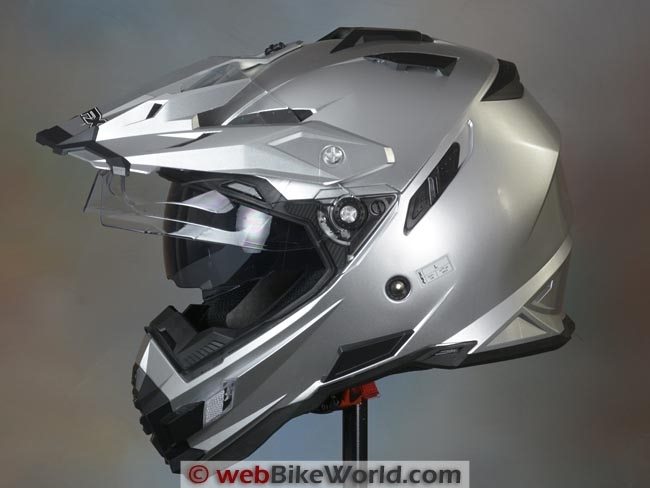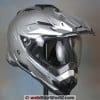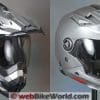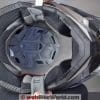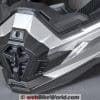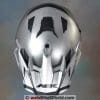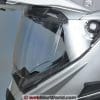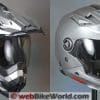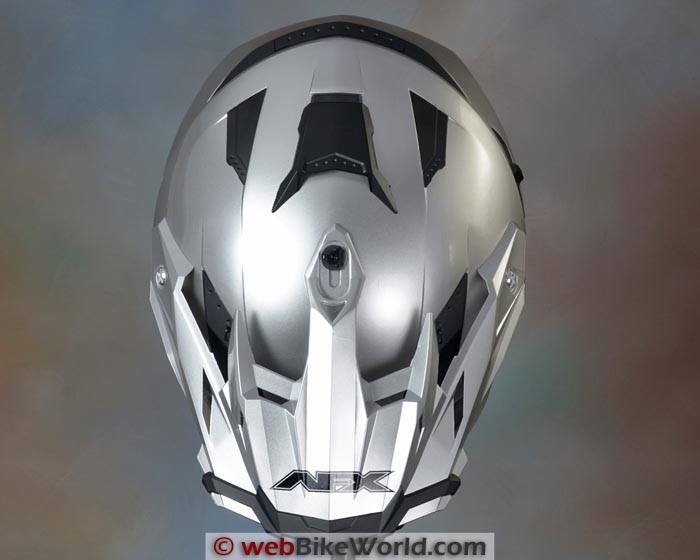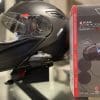The FX-41DS is a very angular take on the dual-sport helmet and it has several important feature differences from earlier AFX DS (Dual-Sport) helmet designs.
For example, compared to the very popular AFX FX-39DS (review), the peak is new and it’s mounted independently from the face shield rotating mechanism.
Also, the face shield removal system on the FX-41DS has been revised for easier removal.
FX-39DS fans will be pleased to know that the AFX FX-41DS is an addition to the DS lineup, not a replacement.
The face shield has a new design that places a goggle-like eye port in front of the rider’s eyes, while the rest of the face shield is angled away. The helmet also includes an internal sun visor.
This means there’s a large eye port area in visual contact as you’re looking through the face shield; we think owners will either get used to it (we did) or not.
Like the FX-39DS, the AFX FX-41DS is a lot of helmet for the money and the build quality has improved quite a bit since the original AFX FX-37DS we reviewed five years ago.
The FX-41DS isn’t perfect by any means but it would be hard to find any helmet — much less a good-looking dual-sport helmet with an internal sun visor — that is its equal, considering the $130.00 or so asking street price.
The DS or Dual-Sport helmets from AFX have been very popular and no doubt help carry the company’s yearly sales figures.
AFX DS helmets have always been a good value that give riders both the looks and features they demand at a price that’s way lower than, say, an Arai XD4 (review).
Of course, as with all AFX helmets, “You ain’t gettin’ somethin’ fer nuthin'”, as the saying goes.
While the overall quality has improved over the years (including the quality of the face shields and sun visors), AFX would be the first to tell you that their helmets are built to a price.
That’s fine, because not everyone wants to or can spend mega-bucks on a motorcycle helmet. And a dual-sport helmet might not be a rider’s full-time lid, so a low price can help justify buying another specialty helmet…or two.
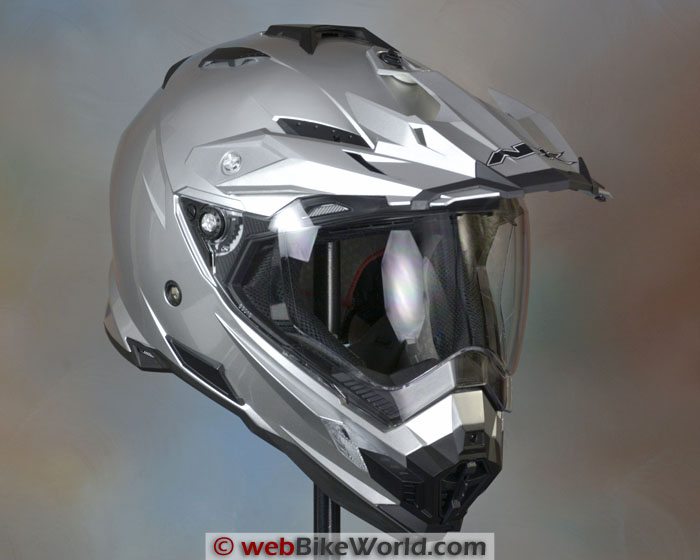
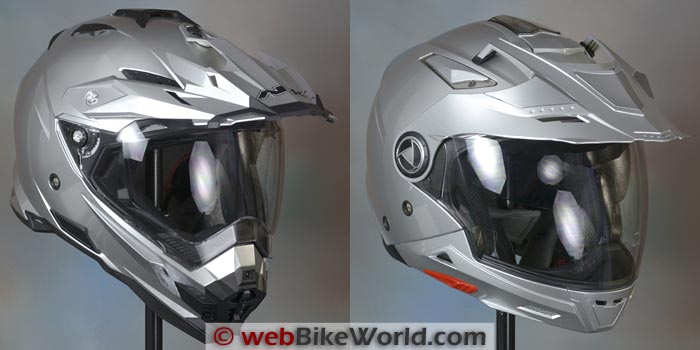
The AFX FX-41DS: Paint, Graphics and Overall Quality
The AFX FX-39DS (review) continues in the AFX helmet lineup and the FX-41 DS is a new and different design. It’s (much) more radical-looking than the FX-39DS, thanks to its very sharp angular approach.
You might not notice the difference at first until you see both helmets together, and then you’ll realize that what was once radical (the FX-39DS) now seems a bit tame.
That’s part of the plan, however, with possibly a market differentiation between dual-sport riders and adventure-tourers preferring one helmet over the other. That’s slicing the niche pretty finely, but it’s the only way we can figure the existence of both.
The FX-41DS comes in silver, black, matte black, white and “Safety Orange” or yellow high-visibility colors.
The Safety Orange color used by AFX is about as high-viz as you’re going to see and it really pops at dawn and dusk; in fog and it’s even more visible in mid-day during bright sunlight, where yellow can sometimes look washed-out.
The silver paint on this one is nicely applied; again, we’re not talking Shoei quality here but it’s a decent paint job with a clear coat that should hold up for the duration.
There are a lot of moving parts on the FX-41DS and their quality is good, although some of the vent covers don’t have a solid or precision feel. There were also quite a few “spider-web” type glue remnants on ours, but those can be easily and quickly removed.
The liner is very comfortable, with a thicker padding than the AFX FX-55 that’s also in our review pipeline.
The thicker lining helps to give the FX-41DS a noticeably more solid feel and a quieter riding environment than the FX-55 also.
The dual lift tabs in the center of the face shield that were found on the FX-39DS continue on the FX-41DS, as does the European-style micro-click quick-release chin strap (although the chin strap cushioning is Arai short).
AFX helmets now also meet both ECE and DOT safety standards and AFX is now distributed and sold in Europe also.
The face shield and sun visor quality have been improved; this issue affecting older AFX helmets was discussed in previous webBikeWorld AFX helmet reviews but the company has worked with their suppliers and the latest quality is a big improvement.
Score: We’ll give the AFX FX-41 DS an “Excellent” rating for graphics, design and overall quality. See the Summary Table at the bottom of the page for a description of our rating system..
AFX FX-41DS Helmet Fit, Internal Shape and Liner
Like the FX-39DS we reviewed back in 2011, the FX-41DS for this review is also a size large.
However, unlike the FX-39DS, this FX-41DS in large now definitely fits much more like a size L, without the roomy half-size-too-big fit of our FX-39DS.
The AFX size chart lists a size large as an appropriate fit for a 60-61 cm head, but our opinion is that this size large FX-41DS fits closer to a 59-60. This compares to the FX-39DS in size L that we reviewed, which had a fit more like an XL, for a 61-62 cm head.
Since AFX now sells helmets in Europe and the ECE 22.05 headform is used for testing, their helmets now have that “Euro” fit and internal shape that we’d call “Slightly Narrow” to “Neutral”.
The internal shape feels much like a typical Shoei or Nolan than, say, the more round fit of the HJC CL-series helmets like the HJC CL-17 (review).
As another reference point, the FX-41DS has an internal fit that feels similar to the HJC FG-17 (review), which has a different internal shape from the lower-priced HJC CL-series helmets.
The bottom line here is that the AFX FX-41DS should fit “Slightly Narrow” to “Neutral” head shapes best and the size L should fit a 59-60 cm head.
[UPDATED] AFX said that the FX-41DS has two shell sizes, XS-M for the small shell and L-XXL for the larger shell.The size large helmet is the smallest size in the larger shell and it does feel a touch short along the bottom, so perhaps the size XL would have been a better choice for us (even though L is our normal review size for motorcycle helmets).
The liner material used in the FX-41DS feels very comfortable, if a bit soft, with a texture that is sort of a cross between microfiber and polar fleece.
Again as in the FX-39DS, the roomy ear pockets of the FX-41DS are roomy and unlined at the shell and with a plastic section fitted, which should act as a very good anchor for gluing in some Velcro speaker holders.
Straight-frame sunglasses fit in this helmet the rounder the head, the tighter the fit.

More information on helmet fit can be found in the webBikeWorld Motorcycle Helmet FAQ page, along with the chart that lists the helmet weights of webBikeWorld reviewed helmets and also by shape on the webBikeWorld Motorcycle Helmet Shapes page.
Score: We give the AFX FX-41DS an “Excellent” rating for shape, comfort and padding with a comfortable liner and padding.
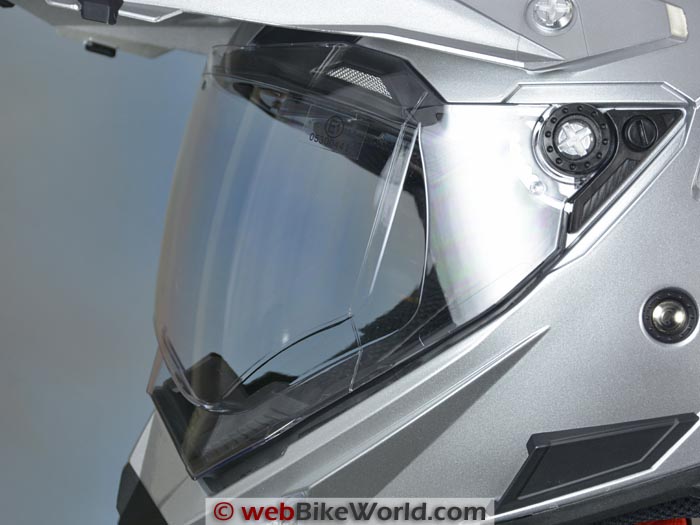
AFX FX-41DS Face Shield, Eye Port, Visibility and Peak
Face shield optical quality was an ongoing issue with AFX helmets in the past, with riders on forums and other reviewers in agreement.
But ever since the AFX helmets have been sold in Europe and meet ECE standards, the optical quality of the polycarbonate has improved.
The only big issue to note with the new face shield in the FX-41DS is that it has a severe angular molding around the periphery.
It’s almost like a recessed section was molded in to fit goggles, but apparently it was done to reduce distortion on what might otherwise be a very curved face shield on this helmet.
The angles form a definite visible line as you’re looking out the eye port and some owners may get used to it while others may not.
The face shield has two lift tabs, located at the lower center part of the shield on either side of the curve that covers the extended chin bar.
This is a nice touch and makes it handy to lift the shield with either hand. It also helps prevent some of the twisting that is expected on a large and compound shape face shield used on this type of helmet, although it hasn’t completely eliminated it.
Like the FX-39DS, it’s difficult to get a face shield with this shape to seal tightly against the eye port gasket, although this one does a good job. The FX-41DS also passed the “leak down” water test, where we run water over the top of the visor where it seals along the top of the eye port.
The eye port gasket is continuous around the opening, which also helps to maintain the seal.
And once more, using lessons learned from the highly successful FX-39DS, although it doesn’t have a first small opening position for defogging, the face shield can be opened slightly and it will stay open just a crack through the friction in the lifting system.
There are only two detents; one lifts it half-way and the other is full open.
But defogging isn’t quite as important on this type of helmet, because a lot of air flows up from under the extended chin bar and also because the chin vent on the FX-41DS is very effective.
Considering the angles molded into the face shield, the eye port of the FX-41DS yields better-than-average horizontal and vertical visibility.
The peak on the FX-41DS is different and more angular than the peak on the FX-39DS. It works well and feels sturdy and it does block the light when the sun is overhead but it can vibrate when hit with turbulent air from some windscreens.

Score: The AFX FX-41DS has a non-standard face shield profile. We give it a “Very Good” rating overall.
AFX FX-41DS Ventilation and Air Flow
The chin vent on the FX-41DS is large and generally nearly identical to the FX-39DS vent. It has a plastic screen inside the chin bar on the nice chin bar liner, so the air does flow directly through to provide a volume of air.
The inside of the chin bar on the FX-41DS is also finished very nicely in a sort of carbon-fiber look cloth.
The system provides good air flow when the switch on the front opens the shutter-like vent.
The switch doesn’t have the most secure feeling and there’s some play in the plastic vent part, but nothing out of the ordinary for a helmet in this price range and it feels perfectly acceptable.
The FX-41DS does come with a small chin curtain, which helps. There is some air and noise that come from the split between the cheek pads and the rear of the helmet. This area falls just under and behind the rider’s ears.
Also, the peak can vibrate in the air flow of some windscreens, mostly the adventure-touring types like the BMW GS, KTM Adventure and Suzuki V-Strom whose owners make up the largest segment for this type of helmet.
The helmet has two small side vents on the top and each one opens with a small stick-like handle on top. A center vent on top has a cover that opens a sort of Venturi ram-air channel that’s supposed to allow air into the helmet.
The liner does have some openings but it also covers some of the vents so it’s difficult to tell if the top vent has direct air flow volume or not.
Overall, the ventilation system on the FX-41DS is acceptable but the upper ventilation doesn’t seem as effective as we remember the FX-39DS system to be.

Score: We rate the ventilation system of the AFX FX-41DS as “Very Good”.
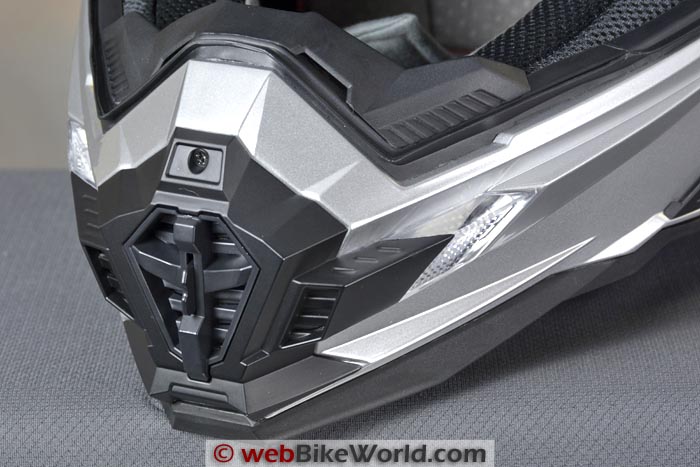
AFX FX-41DS Sound Levels
The older FX-39DS was quieter than we expected when we reviewed it, but the FX-41DS isn’t. The FX-41DS is about average to slightly louder than average.
Part of the problem is the aerodynamics of the peak, which vibrates under certain conditions, especially when riding behind the windscreen of a BMW GS, KTM Adventure and Suzuki V-Strom.
The vibration creates noise and also the air coming through the split between the cheek pads and liner in the rear generate some noise also. This is the area where the helmet curves upward due to the design.
The severe curvature or angles also make it a bit difficult to mount an intercom, so you may have to use the stick-on type or a two-piece intercom like the Sena SMH10R (review).
Other dual-sport helmets that are quieter include the (expensive) Shoei Hornet DS (review) and off-road helmets like the Fulmer RX4 (review). The FX-41DS has the same noise issue as the AGV AX-8 Dual EVO (review), which also has noise coming from the split between the cheek pads and liner.
Bottom line: the FX-41DS isn’t as quiet as the FX-39DS, especially when riding a dual-sport bike with a windscreen — the type of bike probably owned by most buyers of this helmet.

Note that our helmet evaluations are a combined effort of several riders over time on different types of motorcycles with and without windscreens.
Evaluators wear correctly fitted, high quality ear plugs (even when evaluating motorcycle intercom systems).
Always protect your hearing when riding a motorcycle. See the wBW Earplug Reviews for more information on choosing and wearing earplugs.
Note also that perceived noise levels will vary, depending on the individual.
Noise can be caused by many factors, including helmet fit, the type of motorcycle and windscreen, wind speed and direction and even the rider’s clothing.
For more information on helmet noise, visit the wBW Motorcycle Helmet Noise page.
Score: We’ll give the AFX FX-41DS a “Very Good” rating for slightly worse than average noise control.
Helmet Weight
This FX-41DS in size size large weighs a fairly hefty 1845 grams (the FX-39DS in size L weighed 1784 grams. That means it’s over 4.0 lbs. of old-school weight, for a total of 4 lbs., 1-1/8 oz.
That means it’s heavy, although the nice-fitting liner helps keep things in balance. The polycarbonate shell, peak, big face shield and internal sun visor all add to the weight.
Helmets in this weight range include the Caberg Sintesi 2 (Flip-up) in size large at 1772 grams; theNolan N90 (Flip-up, size L) at 1784 grams; the Bell Vortex (L), also at 1784 grams; the Scorpion EXO-400 (XL) at 1785 grams and the Shoei Multitec (XL) at 1786 grams.
Other Dual-Sport or “Enduro” helmets for comparison include the Icon Variant in size L at 1697 grams; the Arai XD (XL) at 1693 grams; the Arai XD3 (L) at 1675 grams and the Shoei Hornet (XL) at 1542 grams.
The aerodynamics of the FX-41DS are pretty good, with light buffeting and lift felt at higher RPMs from the wind on the peak.
Note also that all of the helmets reviewed on webBikeWorld have been weighed and the weights are available on the wBW Motorcycle Helmet Weights page, along with a chart that lists the helmets by weight and shape on the wBW Motorcycle Helmet Shapes page.
Score: We give the AFX FX-41 DS a “Very Good” rating for its acceptable weight for this type of helmet and its good balance.
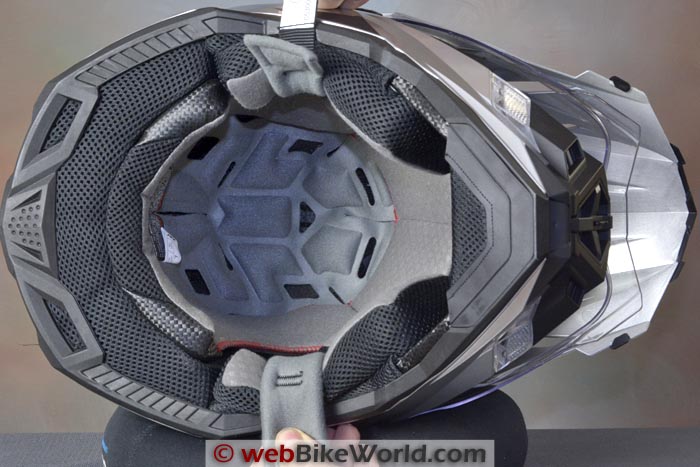


Miscellaneous
The helmet has a “Microlock” ratchet-type chin strap system, but there is no loop for the extra length of strap. The webbed chin strap is longer than normal, so this is somewhat of a problem.
It can be tucked in under the secured chin strap or you can cut it and then heat it with a flame to seal the end. The fabric chin strap cushions underneath are too short though; AFX copied Arai unfortunately with these (Arai helmets have some of the shortest chin strap cushions in the world for some reason).
AFX offers a “lifetime” warranty on their helmets. The expected life of the helmet is 5 years, so in effect, this is a 5-year warranty, which is outstanding for a helmet in this price range.
The helmet is labeled as meeting both DOT and the ECE 22.05 safety standard (more) and it’s sold in both the U.S. and Europe.
AFX said that they “keep parts for every model we have ever sold for 10 years. After our distributor stops stocking parts in the 5th year, the replacement parts are offered at no charge for dealers and consumers”.
The company also offers a “no questions asked accident replacement policy, if you have an accident with any AFX helmet and return the helmet to our office, you may choose any current AFX helmet as a no charge replacement.
We used these survivor helmets at shows and schools to educate the benefits of helmet safety.”
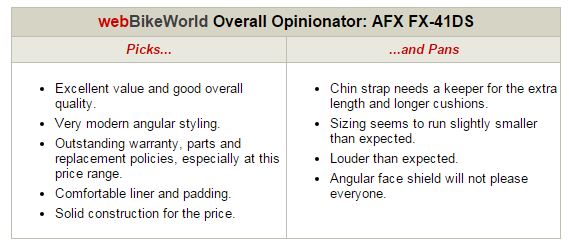


Conclusion
The AFX FX-41DS is nothing if not a super value. It’s hard to think of another helmet — especially a dual-sport helmet — with this many features at this price.
The FX-41DS is different from the popular FX-39DS (review) and it would pay to read both reviews to make sure you know which helmet you want.
The face shield angles may bother some riders and noise control is a bit weak, probably caused by wind turbulence generated by all those angles.
AFX has an outstanding 5-year “lifetime” warranty and parts support, along with the accident return policy and their helmets always represent a good value.
With the improved optics quality and feature set, if you don’t want to spend more than 150 bucks on an adventure-touring helmet, this is the one to get..
Owner Comments and Feedback
See details on submitting comments.
From “H.B.” (May 2016): “I have just bought this helmet from RevZilla. As I’m on the ship, I haven’t tried it yet (on a bike), but I did try wearing it in my cabin (behind the closed door, so that my crew would not think that the old man has gone off his rocker!).
Well, first the good: Sizing and shape is apparently spot on for me.
AFX is one of the few manufactures that list M size as 58-59, which is perfect for my 58.5 head. With most of the others, if I order M without trying, I’m taking a gamble.
Helmet does have cutouts (sort of?) for speakers so I guess that will also work without warping my ears too much.
Now for the bad — very bad. I’m 64 and I always have to wear glasses when riding.
It is not that I need glasses for far objects, like the road and other traffic, but if I want to be able to read GPS or bike’s clocks (and I always do) I have to wear shades with bifocal stick-on (normally +2). I get those from the Amazon, and they mostly have quite thick temples.
With most of my other helmets (HJC, Akuma, AGV… all pure race helmets) I never had a problem with that. But AFX 41-DS is completely useless when it comes to wearing glasses.
The top plastic snap that holds the upper part of cheek pad is placed right in the path where the temple for the glasses should pass.
I have tried with 3 of my regular bifocal shades, and I always have to give up between 10-30 minutes, because of the pain buildup.
In a way, I guess that I’m lucky that I tried first with a very cheap DS helmet. Now I can just chuck it overboard, and go and spend 500$ for something that will work.
However I will admit that I did not read your review before I bought this helmet. Maybe I should have, although it would probably not help, as you say that glasses do fit. It probably depends on the type of glasses one uses.
I mostly use photochromic shades with bifocal stick on built in (like Tiffosi). These always come with relatively thick rubberized temples.
The reason for photochromic is (I do know that they do not work under the helmet visor), is that when I stop, I can just continue wearing them as a proper shades when off the bike. That was also the reason for buying DS helmet with internal sun visor.”
Editor’s Reply: Usually when eyeglasses don’t fit between the helmet liner and the wearer’s head, it’s because of a mis-match between the head shape and the internal shape of the helmet.
I have a lot of problems with this, because I have a “wide” head that is widest at the temples. So on helmets that have a “Neutral” or “Slightly Narrow” internal shape, there sometimes isn’t enough room to fit my eyeglasses.
Also as you mentioned, the seam or space along the top of the cheek pads where they meet the liner can sometimes interfere with eyeglass temples. That’s poor design on the part of the helmet manufacturer.
Anyway, thanks for the feedback and smooth sailing!
From “R.V.” (June 2015): “I am surprised you didn’t mention the fact that the FX-41 ships with a kit of side plates so that you can remove the peak and use it as a converted “street” helmet.
I’m actually planning on buying a second one for myself and running it without the peak just for street rides.
I found I grew accustomed to the visor bottom edge. I have not tried the helmet with goggles yet. When off-road and I need air, I usually flip up the outer visor and run with the inner shield down for eye protection.
Regarding the extra length of the chin strap, I simple cut the extra length off mine once I got it adjusted to my liking. Since it has the ratchet mechanism instead of D-ring this doesn’t affect the security of the helmet on my head. I simply sealed the cut end with a bit of heat.
I also like that the liner is fully removable on a helmet in this price range. I get very sweaty riding off-road on my Elefant and KTM 450EXC, so this is a key feature that you also did not seem to mention in your review.
Thanks for the awesome website!”


